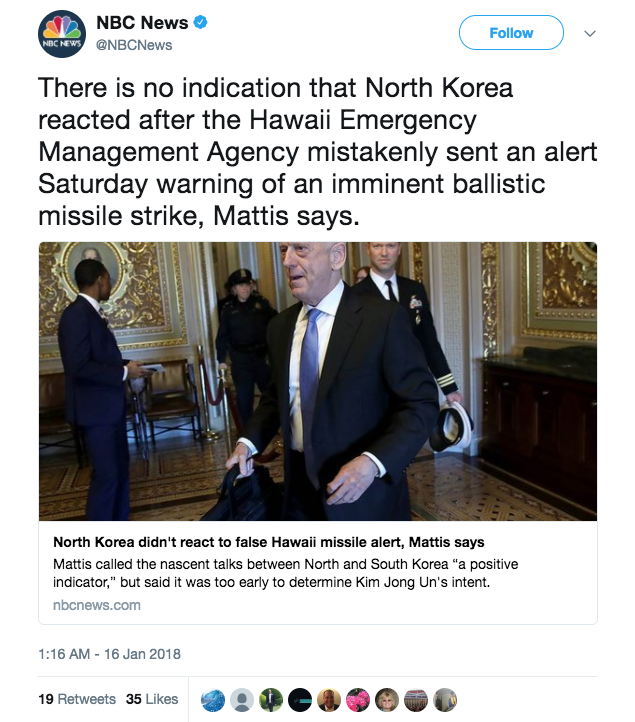North Korea did not react to the accidental emergency alert sent by the Hawaii Emergency Management Agency warning of a ballistic missile strike on Saturday, Secretary of Defense James Mattis told NBC News.
“No. There is no information like that that I have,” Mattis told NBC News when asked if North Korea had a reaction toward the false emergency missile alert.

NBC News (Twitter)
Mattis said that North and South Korea did not use their recently reinstated hotline for communications to confirm that North Korea did not fire a ballistic missile at Hawaii on Saturday.
Earlier this month, North Korea reopened a military hotline with South Korea to open a direct dialogue with the country, in an effort to ease tensions over the course of the past two years.
Mattis also said the U.S. has military options if diplomatic talks were to fail with North Korea regarding its nuclear missile program.
“The whole point is to reinforce the diplomatic options and to show that there are military options, should there be a DPRK [Democratic People’s Republic of Korea] attack,” Mattis told NBC News. “We’ll show them that there are military options. But it is all couched within a framework of strengthening the diplomat’s hands.”
Just a few minutes after 8:00 a.m. local time in Hawaii, an employee at the Hawaii Emergency Management Agency initiated a routine internal test by clicking the “Missile alert” button in a computer program as opposed to the “Test missile alert” button on the drop down menu.
Hawaiian residents and tourists then received an alert reading: “BALLISTIC MISSILE THREAT INBOUND TO HAWAII. SEEK IMMEDIATE SHELTER. THIS IS NOT A DRILL.”
Televisions had the following warning scroll across the screen: “If you are indoors, stay indoors. If you are outdoors, seek immediate shelter in a building. Remain indoors well away from windows. If you are driving, pull safely to the side of the road and seek shelter in a building or lay on the floor.”
Thousands of people panicked as they saw the alert. It wasn’t until about 38 minutes later that another alert was sent saying the first alert was a mistake.
Changes to the alert system are already being made. Two people, rather than one, will now be necessary for the activation and verification of the alert. An alert cancellation is also readily available and can be issued within seconds if there is a problem.



